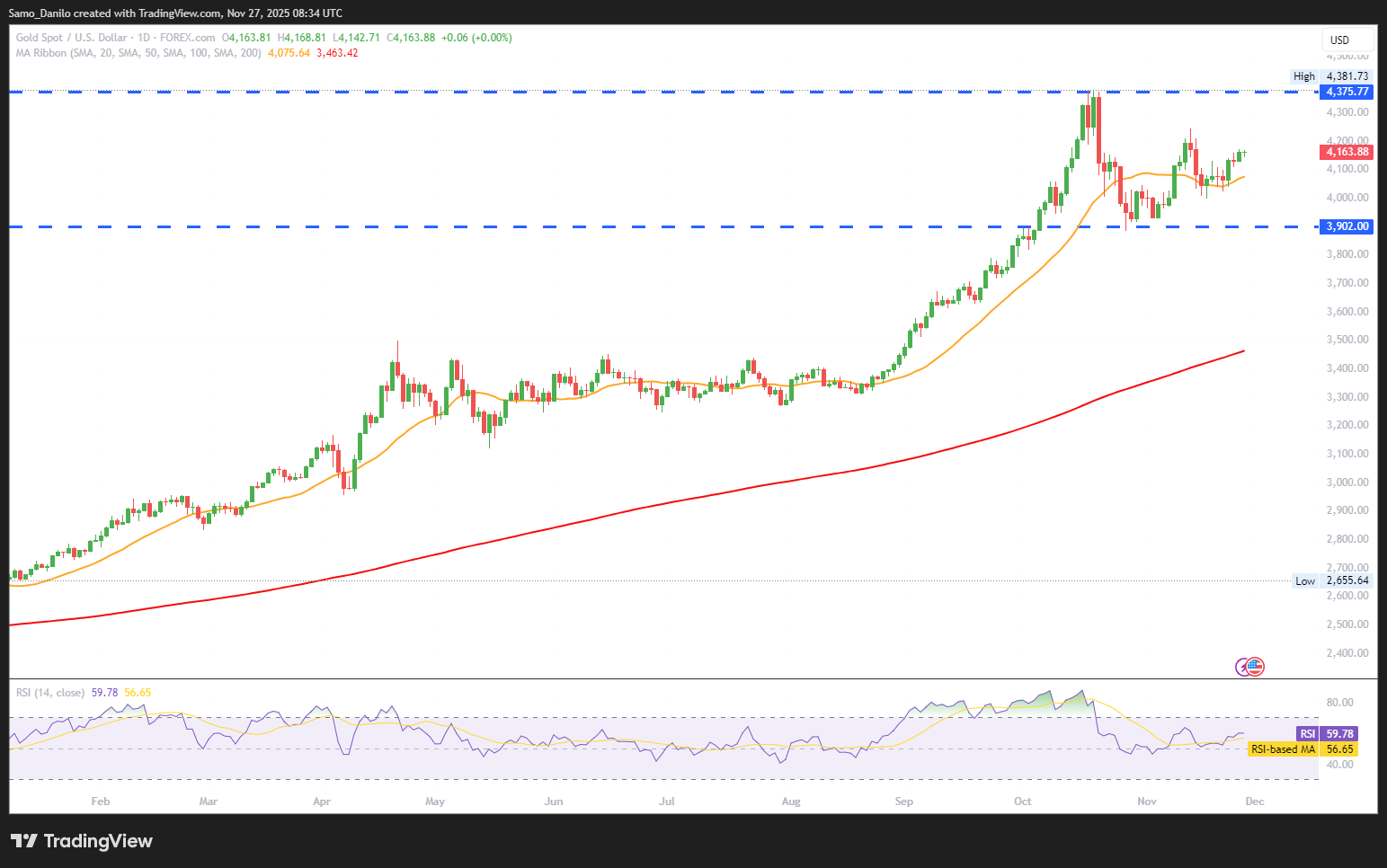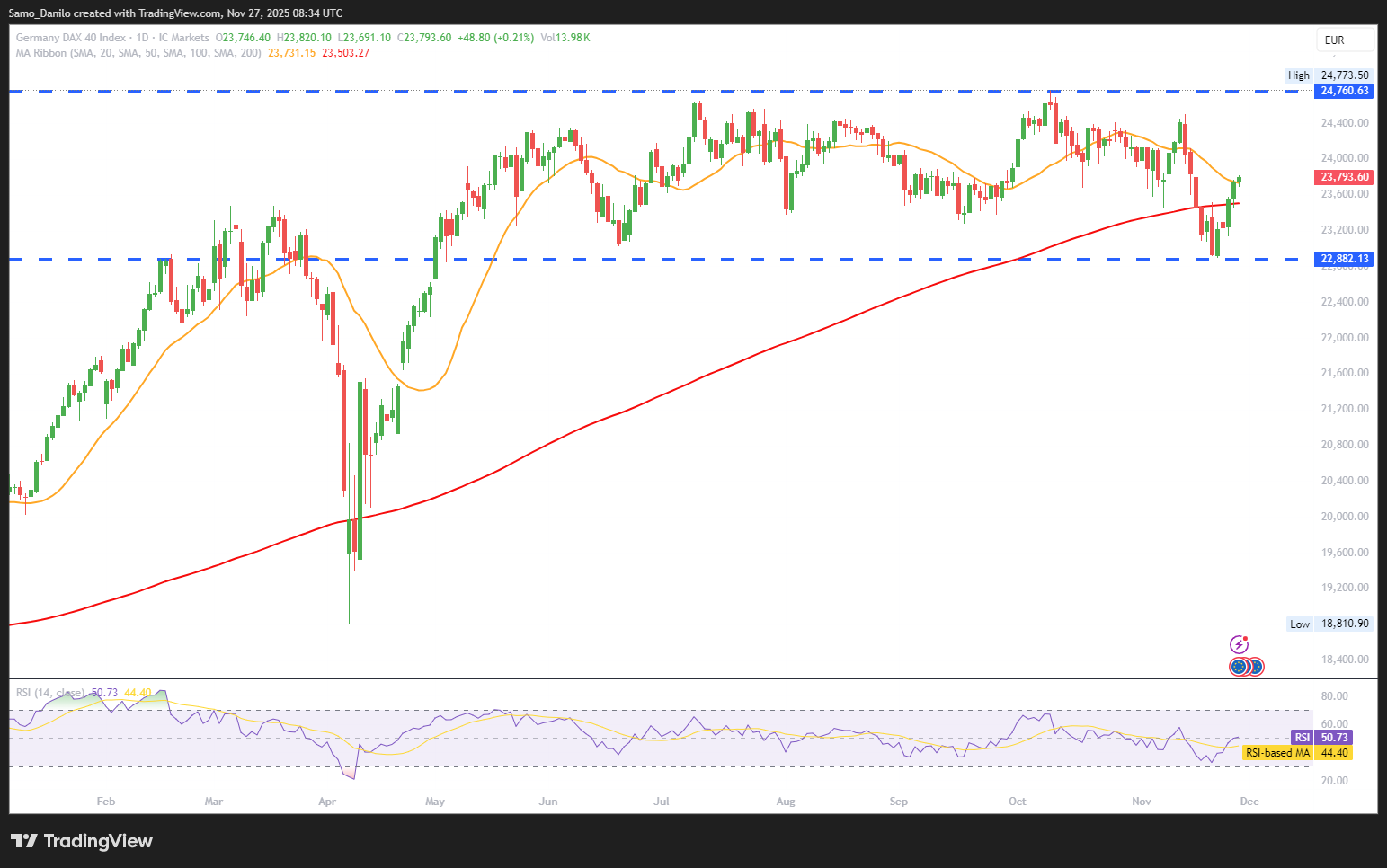EURUSD
- EUR/USD Price: EUR/USD trades near 1.1600, marking a one-and-a-half-week high during Thursday’s European session. The pair holds a positive bias as markets continue digesting steady Eurozone policy signals.
- ECB's de Guindos: ECB Vice President Luis de Guindos offered a slightly more optimistic view on growth on Wednesday, stressing that the current level of interest rates is appropriate. His remarks support expectations that the ECB will maintain a cautious, stability-focused stance.
- ECB's Vujcic: Croatian central bank chief Boris Vujcic reinforced the view that further rate cuts should only occur if inflation moves below target without signs of recovery. This adds to the broader message that the bar for additional easing remains high.
- ECB's Lane: ECB Chief Economist Philip Lane emphasized the need for a continued slowdown in non-energy inflation to keep overall price growth aligned with the 2% target. His tone underscores the ECB’s reliance on upcoming inflation data to determine future policy direction.
- Credit Data: Attention now turns to euro area credit data for October. Loan growth to non-financial corporations rose 2.1% y/y in September, but recent momentum has softened, signaling a smaller boost to economic activity ahead.
Closing statement: EUR/USD remains supported by a broadly steady ECB narrative and slowing inflation pressures that limit the likelihood of near-term policy easing. With the pair holding above 1.16 and market sentiment leaning mildly bullish, the near-term outlook favors gradual euro strength, barring a strong USD resurgence driven by US data.
GBPUSD
- GBP/USD Price: GBP/USD extends its winning streak into a sixth consecutive session, trading near 1.3240 during early European hours on Thursday. The pair maintains strong upward momentum as investors continue rotating out of the US Dollar.
- Budget Shock: The UK Autumn Budget dominated domestic headlines after the OBR report was leaked ahead of Chancellor Rachel Reeves’ presentation. The budget introduces post-war-high tax rates, with Reeves stating that “ordinary people must pay a little more,” creating a cautious but steady backdrop for the Pound.
- Jobless Claims: In the US, Initial Jobless Claims for the week ending November 21 unexpectedly declined to 216,000, beating estimates of 225,000 and marking an improvement from the prior 222,000. The data suggests some resilience in the labor market despite broader signs of cooling.
- Goods Orders: The US Census Bureau reported Durable Goods Orders rising 0.5% in September, slowing from the revised 3.0% surge in August but still surpassing market expectations. While softer, the figure indicates that demand for long-lasting goods remains stable.
- Fed News: Federal Reserve Governor Christopher Waller reiterated early this week that the labor market is now weak enough to justify another quarter-point rate cut in December, reinforcing dovish policy expectations and adding downward pressure on the US Dollar.
Closing statement: GBP/USD continues to benefit from broad USD softness and dovish Fed sentiment, while UK fiscal developments inject a degree of uncertainty but do not derail the pair’s upward bias. With markets pricing a December Fed cut and the Pound gaining sustained traction, the near-term outlook remains tilted in favor of further GBP strength unless US data meaningfully surprises to the upside.
XAUUSD
- XAU/USD Price: Gold shows a mild recovery but remains under slight selling pressure, reflecting cautious market sentiment during the European session. The metal’s inability to break higher signals lingering bearish forces.
- Fed Rate: Fed rate expectations shifted after reports that Kevin Hassett is a leading candidate for Fed Chair, with markets viewing him as favoring lower interest rates. This reinforces dovish assumptions that typically benefit gold.
- JP Morgan: JP Morgan revised its Fed meeting forecast and now expects a December rate cut, amplifying broader market expectations of policy easing. Such forecasts generally weaken the USD and support gold prices.
- Fed's Miran: Fed Governor Stephen Miran added to the dovish tone, stressing that worsening labor market conditions justify sizable cuts to reach a neutral stance. These comments increase the probability of aggressive monetary easing.
- Ukraine-Russia: Optimism around a potential Ukraine–Russia agreement and expectations of lower US rates boost risk sentiment, favoring equities over safe-havens. This risk-on environment limits upside potential for gold in the near term.
Closing statement: Gold remains sensitive to shifting Fed expectations—dovish signals provide underlying support, but improving geopolitical sentiment and stronger risk appetite may cap immediate gains.
CRUDE OIL
- Crude Oil Price: WTI slips in early European trading, moving to $58.35 from Wednesday’s $58.49 close. The modest decline reflects a cautious energy market with limited bullish catalysts.
- Talks Uncertain: Russia acknowledges progress in US-brokered Ukraine negotiations but warns an agreement remains distant. The absence of concrete concessions keeps geopolitical risk elevated but without clear directional impact on oil.
- Rig Count: US drilling activity dropped sharply, with the total rig count falling by 10 to 544. This marks a significant year-over-year decline of 38 rigs, signaling tightening supply capacity ahead.
- EIA Data: EIA data shows US crude production fell for a second straight week to 13.814 million bpd. Though still near record highs, the dip suggests a potential easing in supply pressure.
- China Industry: China’s October industrial profits fell 5.5% y/y after strong September gains, reflecting soft domestic demand and trade-related export pressures. Weak Chinese data adds a bearish macro layer to global oil demand expectations.
Closing statement: WTI remains pressured by weak demand signals from China and mixed geopolitical developments, while declining US rigs and slightly lower output provide a modest counterbalance. Near-term price direction leans neutral-to-soft unless demand indicators improve.
DAX
- DAX Price: Germany’s DAX 40 trades near 23,750 points, showing relative stability amid mixed economic signals and ongoing market uncertainty.Germany’s DAX 40 trades near 23,750 points, showing relative stability amid mixed economic signals and ongoing market uncertainty.
- IMF Warning: The IMF warns Germany faces a tough medium-term growth outlook unless significant reforms are enacted both domestically and within the EU, highlighting structural challenges.
- Consumer Sentiment: December consumer sentiment in Germany improves slightly to -23.2 from -24.1 but remains subdued. Households are cautiously more willing to spend, tempered by weak income prospects ahead of the holiday season.
- GDP Forecast: Germany’s economy is forecast to grow only 0.2% in 2025 after two consecutive years of contraction, with Chancellor Merz’s fiscal measures still needing time to impact growth positively.
- US Projection: JPMorgan projects the S&P 500 could reach 8,000 by 2026, contingent on more aggressive Fed rate cuts than currently priced in, suggesting external market optimism amid European challenges.
Closing statement: The DAX faces a cautious environment shaped by slow domestic growth and consumer hesitance, despite fiscal stimulus efforts. Global market optimism, particularly from the US, may provide intermittent support, but significant upside for German equities depends on meaningful reform and economic improvement.




